Friday, May 9, 2008
Friday, April 18, 2008
This just in: updates to "10 best AR devices..."
1) Enkin: handheld navigation concept for Google Android phone
2) Apple’s patented head mounted display for iPhone
3) Gaming appearing recession proof, with close to a million handheld game devices sold in March 2008.
Wednesday, April 16, 2008
10 best augmented reality DEVICES that will reinvent mobile video games
Now, let's talk hardware: how in the world are we going to play these games?
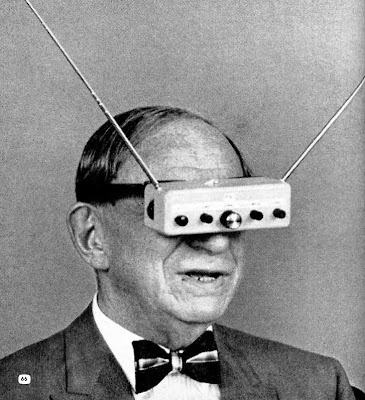
Courtesy of "Window to The Future" By Steve Kosareff
AR game devices run the gamut from 20 lbs-backpack-and-head-mounted-display-systems to tiny handheld cell phones.
Once again, Marshall McLuhan's legacy (“the medium is the message”
Scholars have studied it at length (sidebar); I propose a simplified view spanning 3 generations:
The Past: Generation "Kit Bag"
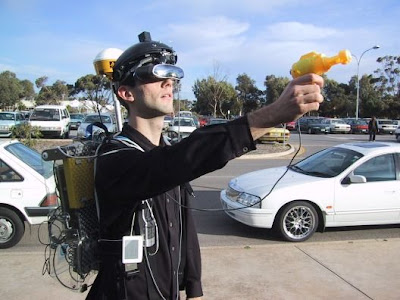
Tinmith epitomizes generation "kit bag"
* took place over the last 10+ years
* custom built backpack with laptop, accessories
* head mounted display
* used exclusively in research
* groundbreaking experience yet -
* heavy, complex, and expensive
The Present: Generation “Hand Bag”
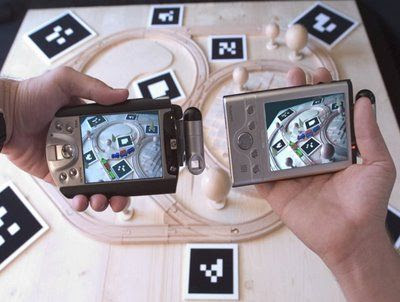
Generation "hand bag" took off with The Invisible Train
* started in 2003 with a horizon of 2010
* mass production: banking on the ubiquity of mobile devices
* aspiring for larger screens with more powerful devices
* easy to carry, ergonomic, affordable, yet -
* occupies hands, limits immersion
The Future: Generation “No Bag”

Leonard Low's concept eyewear for augmented reality
* next 3-15 years
* eyewear: glasses and later contact lens
* handsfree; immersive
* in short: nirvana...(also means in Hindu - the end of suffering)
So, what’s the perfect device for mobile augmented reality games?
Experts argue that it depends on the type of game.
I buy that. Here’s the revised challenge: if game developers want to build a game like Roku’s Reward - what handheld device should they zero in on?
Looking at present and future generations, here is my countdown of the top 10 AR mobile devices with which developers will reinvent video games:
10. PDAs (Personal Digital Assistant)
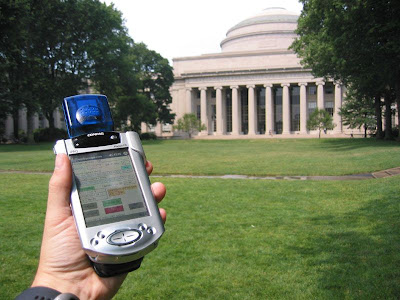
MIT's Environmental Detectives
PDAs knocked out the “kit bag” generation and signaled the dawn of the “hand bag” generation. They delivered mobility and extensibility (it's easy to add a camera, GPS or other accessories) and it offered reasonable processing power.
However, with the convergence of devices such as cell phones, cameras, and the miniaturization of computers - PDAs are becoming obsolete.
Notable PDAs for AR include: iPAQ, Dell Axim, Fujitsu-Siemens, and Asus
9. UMPC (Ultra Mobile PC)

Outdoor tracking with a UMPC at the University of Cambridge
UMPCs are the most powerful handheld devices out there. Its Windows operating system makes it a familiar and practical platform for development.
Sony Vaio UX is used often by researchers; Raon Digital Everun is another candidate.
UMPCs would have been at a higher position on this list - had it not introduced 2 barriers for adoption as an AR game device: price (upwards of $1500) and size (needs a sizable bag). After all, the UMPC is designed for business - not games.
8. Smart Phones
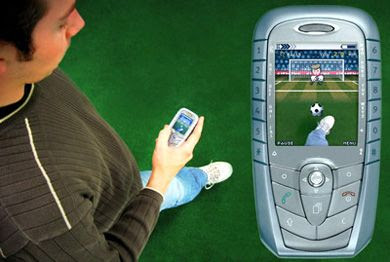
C-Lab's KickReal runs on a Siemens phone
If you're after the masses, smart phones are your best bet thanks to their ubiquity (out of 1.14 billion cell phones sold in 2007 - 10% were smart phones according to IDC) . In two or three years, it will be nearly impossible to buy a conventional cell phone (as agreed at the CTIA wireless show 2008.)
So, almost everyone has them, cameras are getting better, they're adding accelerometers, and positioning capabilities and some games have proven to work on this type of devices.
Popular mobile phones (sorted by OS popularity according to canalys
Google’s Android phone has ambitions to carve its niche, but has still a long way to go (too slow, not stable). It may emerge as a viable option in 2009.
But because of its small screen, low end processors, and major market fragmentation - smart phones cant leap beyond the 8th spot.
7. iPhone

The iPhone could surpass other game devices (Roughly Drafted Magazine )
Though considered a smart phone - owing to its unmatched user experience - the iPhone deserves its own category.
Its form factor, touch screen, accelerometer, more modern technology, and now with an open SDK - it's irresistible.
Although Apple is not known as a great gaming company there are currently 373 games listed under iPhone webapps.
Apple’s total control of the whole product compared with Gphone’s patchwork of multiple companies will result in a better experience.
6. Handheld Game Devices (PSP, Gizmondo, Nintendo DS)
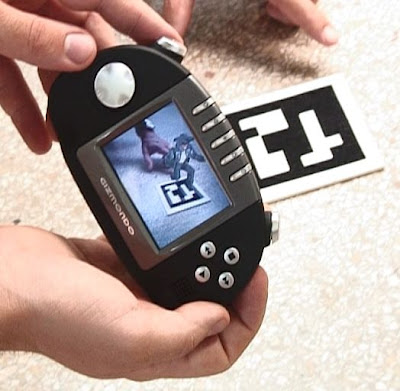
Gizmondo used for the Caleb project at Graz University
Handheld game devices are leading the growth in the game hardware market. Some people believe they will cut into the console market. Devices such as Sony's PSP, Nintendo DS (and Gizmondo assuming it will indeed reemerge) have a great form factor - and the fact that they are designed specifically for games, gives them an edge over general purpose devices.
But here's the caveat: PSP and the DS need to be complemented with accessories such as camera, as well as accelerometers, positioning and ubiquitous connectivity capabilities - to be able to play in this game.
5. Nokia Phones (N Series)
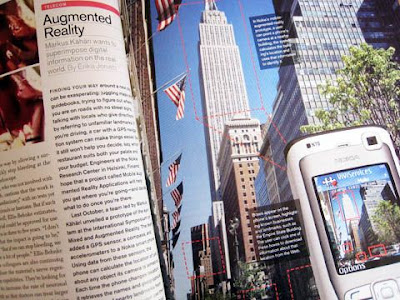
MARA project at Nokia
Haven't we already covered smart phones at #8?. Well, Nokia isn't just another smart phone company. Through extensive research, it pushes the envelop of augmented reality experiments on phones more than any other manufacturer.
Notable devices include N-81, N95, N-810.
The feature packed multimedia heavy N95 stands out as the most popular among researchers despite some limiting factors:
* runs on symbian - not great for heavy programming
* small 2.6” screen with 240 x 320 pixels only
* Expensive (above $500) and not really for mass market
4. MID (Mobile Internet Devices)
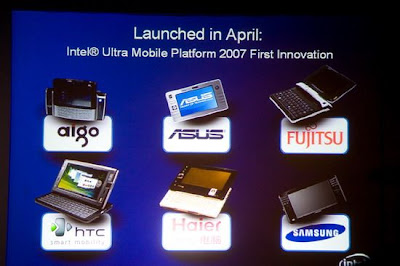
Intel announced these MIDs to be releases in 2008
Intel is putting its muscle behind the MID. The MID is designed for multimedia consumption on the go. It’s extremely portable with an ideal screen size (4-5”); it’s fully connected and armed with a strong (low power consumption) processor. The fact that it runs on a scaled down Linux makes it accessible and fast. But, what really separates it from the UMPC is its sub $500 target price.
Before year end ,Intel hardware partners are planning to release these products: LG Xnote, BenQ, Aigo, Lenovo MID.
Although experts have no real world experience with the MID - it's shaping up as the preferred choice; if you plan to develop an augmented reality game this year - I would single out the MID as your #1 device.
When the flood of MIDs comes upon us, here is the criteria I suggest to separate the wheat from the chaff:
* screen size between 3.5"-5.5" (4"-5" ideal)
* min 65K colors, 800x480 pixels
* strong processor - min 400MHz
* with CGI acceleration (e.g. NVidia APX2500, TI OMAP 3)
* ubiquitous connectivity with cell (3G) and wifi/wimax
* high quality video camera: resolution (640x480), 30 fps
* positioning capabilities (GPS or software based locationing)
* inertial sensors, accelerometers, digital compass
* blue tooth for adding essential accessories
* touch screen - nice too have
* price - below $500; $200 would be ideal for the masses
Now let's delve into the future; here devices become more conceptual, which means - not proven, yet stimulating. Prepare to be audaciously hopeful.
3. Looking glass (design concept)

In its designer Mac Funamizu’s
“This is what I wish the Internet search will be able to do with a mobile device
Will anyone ever build it? I don't know - but it sure looks cool.
2. Glasses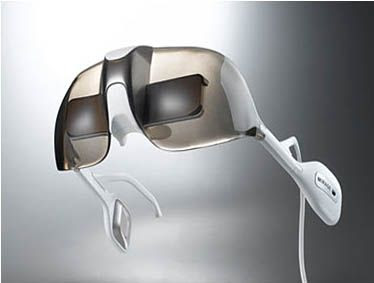
Mirage Innovations is one of the contenders for the future generation
Nokia dubbed mobile phones as the 4th screen (following cinema, TV, PC). According to this count, glasses will be the 5th screen. It spearheads the next generation of augmented reality: the “no bag generation”. This is when we become liberated. Handsfree. The interactive overlays on top of reality surround us anywhere we look. Can we start developing games for glasses? not quite yet. They still lack built in cameras, eye tracking, and tend to cause dizziness. Should we start thinking about it? Absolutely. Rolf Hainich has dedicated a book to this concept and aptly called it the end of hardware

Microvision is working on lightweight eyewear for augmented reality

Lumus Optical has just launched their new and slick eyewear

Vuzix from military to consumer video eyewear
Here is the criteria I’d use to evaluate the progress of contending eyewear companies:
* looks and weighs like regular sun glasses
* see thru, high resolution display
* integrated camera
* eye tracking
* position and movement sensors
* integrated sound
1. Contact Lens

Darpa project for the creation of micro- and nano-scale display technologies
Apart from topping the list of “things you wouldn’t borrow from a friend”, contact lens leap to the top spot of AR devices. Normally, the mere thought would be scientifically dismissed as “too far off”, but this Darpa project
The story is taking place in 2025. Not too far off. Back to the present: Scientists have already created a proof of concept - see image below.

University of Washington prototype of a similar gadget
Didn’t make the list
*Laptops - laptops were used extensively during the “kit bag” generation as a key ingredient of the back pack, but during the hand bag generation - no one wants to the roam the streets tethered to a laptop. First implementation of Plundr
*Zune - should it be?...
*Brainchips - beyond the horizon of contact lens lies the world of brainchips
Many thanks to the expert contributors: Daniel Wagner, Charles Woodward, Blair McIntyre, Peter Wojtowicz, and Jose Carlos dos Santos Danado (YDreams).
What's your take? I really want to hear from you.
Cast your own vote!
Monday, March 3, 2008
Top 10 augmented reality demos that will revolutionize video games
10. Human Pac Man
In 2006 the Come Out & Play Festival turned New York City into a playground for a weekend, then did the same for the city of Amsterdam in 2007. Hundreds of players gathered to play dozens different Big Games across each city.

"Magical monsters appear from shadows cast by the hands of participants, reacting to gestures with sound and animation. Wolf like creatures, birds and a rastafarian are among the characters that speak and squeek as imaginary mouths open and close. Shadow Monsters is an intuitive and magical experience for young and old alike to play with body posture for creating crazy narratives."
- A handheld camera device,
- live video overlaid with 3D graphics,
- computer recognition - identifying real life objects,
- positioning and acceleration sensors,
- virtual objects interacting with reality,
"There was something familiar about this prey. It was young and clever looking ... a newborn from Juan's own design! And that meant its Mommy would be nearby. Juan said, "You know, I don't think --"
"The Problem Is, None Of You Think Nearly Enough." The sound was premium external, like sticking your head inside an old-time boom box. Too late, they saw that the tree trunks behind them grew from yard-long claws. Mommy. Drool fell in ten-inch blobs from high above.
This was Juan's design scaled up to the max."
Cast Your Own Vote!

 reddit
reddit del.icio.us
del.icio.us